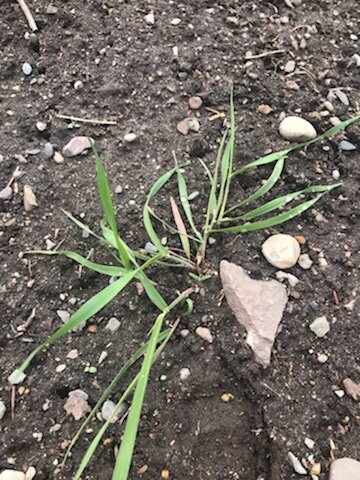Missoula's Most Ubiquitous Weed - Quack Grass!
Gardening is a lot about getting to know plants, and unfortunately these plants aren’t always vegetables and flowers. Weeds are a big part of gardening, and knowing how to identify and deal with each of our most prevalent weeds will go a long way in gardening. One ubiquitous weed is Quack Grass. In this blog, I’ll go over how to identify and deal with quack grass in your garden.
On the left is a small quack grass clump— this plant can spread through it’s underground rhizomes, so often you’ll see smaller clumps like this away from a larger patch, like shown in the middle picture. The photo on the right is a single stem of quack grass.
IDENTIFYING QUACK GRASS
Here you can see the light colored auricle where the leaf meets the stem.
You’re probably familiar with quack grass, whether you realize it or not. It’s an invasive weed from Europe that can now be found all over the United States. It’s the sod-forming grass with long and wide leaf blades that come to a point at the tip. It tends to be a lighter color than turf grasses, making it stand out in your lawn. Quack grass also has auricles, which are little structures at the base of each leaf that wrap around the stem, though these sometimes split as the plant ages. For gardeners busy weeding, the best identifier is the whitish rhizomes, which can be confused for roots. The rhizomes are part of the plant’s reproductive strategy and are sort of horizontal underground stems.
DEALING WITH QUACK GRASS
Quack grass is most problematic because it’s a perennial (meaning winter doesn’t kill it) and it has dual reproduction strategies. It can reproduce through seeds, and it’s rhizomes. That means the whitish stems we see underground can make new plants, which explains it’s ability to spread out from larger clumps before it’s gone to seed.
Like all rhizomonous weeds, you have to be careful in dealing with it. Roto-tilling, for example, can be helpful in breaking up the thick mats the plant forms over time, but can present more of a problem in the long term. Breaking up those rhizomes make small pieces that can form a new plant, so you have to thoroughly sift through the freshly loosened soil after roto-tilling to find as many of these pieces as you can.
For an established garden with quack grass, I recommend using a digging fork to clear as much of it out as you can early season. For this, I loosen the soil with the fork—not just where the grass is emerging, but all around it too. Then, I carefully pull the grass out and try to pull as much of the rhizome out with each clump of grass as I can (and it can be a lot!) The rhizomes can grow to almost ten feet long! As you can see in the picture below, I was able to pull almost two feet of rhizome off a plant that only a few inches tall.
Deep weeding like this is a great thing to do early season as you’re preparing your beds for planting, as you’ll loosen the soil and fight back quack grass all at once.
ONGOING MAINTENANCE
If there are starts or vegetables in the ground, or let’s say, quack grass is invading an area with perennials, you’ll want to switch to a different method than I just mentioned above. I still recommend using a digging fork and pulling out as much of the rhizomes as you can from that one spot. You can also switch to using a smaller more precise Hori Hori (a Japanese gardening knife) or hand trowel to tackle the grass. Worst case scenario, just keeping plucking the grass out of the soil as often as you can. Eventually, the roots will run out of stored energy and stop producing new plants. However, the plant can keep energy stored for years, so it’s good to get as much of the roots out as you can early on. Although I’ve only mentioned removing rhizomes in this blog, it’s important to prevent quack grass and all weeds going to seed! Quack grass seeds can remain viable for 3-5 years in the soil—this plant is hardy!
Another small clump of quack grass I pulled out—the rhizome stretched over 6 feet and has put out at least 6 new plants!
MORE INFO:
We’ll be doing a Facebook live on Tuesday, May 12th at 11. I’ll be going over what’s happening at the Providence Garden this week, and tackling our bindweed corner. Tune in on our Facebook page to watch me put these steps to use!






